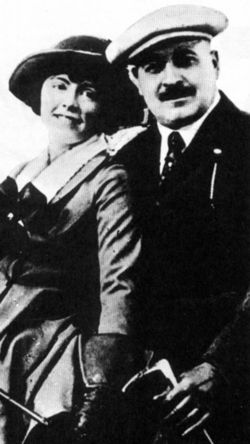Jim Colosimo (Jim Colosimo)

Organized Crime Figure. Colosimo was ten years old when he left Italy with his family destined for Chicago. As a teenager he began supplementing his income with thievery, including pickpocketing, and by the time he was 18 he began engaging prostitutes to work for him. Early in his career he took up the Italian practice of sending Black Hand letters to wealthy citizens of Chicago. These anonymous messages threatened violence unless money was paid, and were usually signed with an imprinted black hand. While working as a pimp he also worked for the Chicago sanitation department. After several years he was promoted to foreman. The aldermen for the First Ward at the time were two Democrats, saloonkeeper Michael “Hinky Dink” Kenna and a bathhouse owner named “Bathhouse” John Coughlin. As aldermen, Kenna and Coughlin had plenty of political clout in Chicago and consequently, they were able to control the city’s brothels They hired “Big Jim” to collect protection money from the city’s pimps. One madame who bought the protection was Victoria Moresco, a woman who fell in love with Colosimo. They were married in 1902, and by then Colosimo owned a pool hall, a saloon, and now his wife’s bordello. Combined with his share of the generous contributions to the Democrats, he was fast becoming a wealthy man. He and his wife opened many more prostitution dens and muscled in on the businesses of other pimps. At the height of his power, Colosimo owned or shared profits of an estimated 200 whorehouses. Prostitution was a booming industry in the Levee district, and supply was far outweighed by demand. Chicago needed a new source of hookers, so the Colosimo’s set up Chicago’s White Slave Ring with another couple. The slavers kidnapped young girls, beat and raped them into submission and sold them to pimps for $400.00 each. They specifically targeted immigrants who could not speak English. Colosimo’s wealth did not go unnoticed, and in 1909 he because the target of a Black Hand letter, similar to the ones he used to send. Fearing violence he agreed to the terms of the letter and paid up. However, it wasn’t long before the next letter arrived, and he realized that no matter how much he paid, they would continue to harass him. The only solution would be to ambush those extorting from him. The drop off point was at Archer Avenue, and Colosimo left an empty suitcase in place of the money. When the extortionist’s showed up they were shot dead by a group of Colosimo’s gangsters led by Johnny Torrio. Colosimo was so impressed by Torrio that he became his New York connection. “Big Jim” by now was a celebrity, mingling with judges, politicians and entertainment stars. He gang, known as the “Outfit”, was the most successful criminal organization in Illinois and he had become known as “Diamond Jim” because he displayed his wealth by covering himself in jewelry. His restaurant, Colosimo’s Cafe, had become a Chicago institution, the eating place of the rich and famous which opened in 1910. Over the years there grew animosity between Colosimo and Torrio. Torrio wanted to expand the business and Colosimo was satisfied with his monthly income of $50,000.00. Torrio also was upset that Colosimo divorced his wife Victoria who happened to be Torrio’s aunt. On Tuesday, May 11, 1920, Torrio set up a hit on Colosimo at his restaurant under a ruse that Colosimo needed to be at the restaurant to deal with bootleggers. At 4:25 PM, while leaving the restaurant, he was shot by an assassin who was hidden in a closet. The only witness later testified that it was Johnny Torrio’s lieutenant who had killed Colosimo. The witness refused to testify and the charges were dismissed. Years later, doubt was cast over the witnesses version when Al Capone allegedly confessed to the murder of “Big Jim” during a conversation with journalist Charles MacArthur, who was well known for his associations with mob figures. Colosimo’s funeral was nothing short of extravagant. The procession was lead by 53 pallbearers with judges and congressmen among their ranks. Over 1000 members of the Democratic Party marched to the tune of two brass bands.
Born
- April, 17, 1877
Died
- May, 11, 1920




